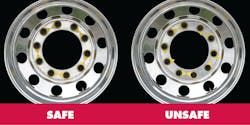A shorter indication arrow allows for Checkpoint unit placement in pairs so that they point toward each other in a point-to-point configuration that offers a preferred option over the “daisy chain” (where the indication arrows point in a clockwise direction) because of easier detection of lug nut movement.
Slight movements of lug nuts that may have gone unnoticed before can now be seen earlier and with greater certainty.
IMI says loose wheel nut indicators have been introduced to the U.S. market over the last few years and have helped many fleets improve their wheel torque programs. However, there is a misconception in the industry that these indicators prevent loose wheel nuts. In reality, they only visually indicate when a wheel nut is starting to loosen and has moved.
Checkpoint’s real benefit for fleets and tire dealers is to provide an early warning of loose wheel nuts and make wheel safety checks more efficient.
The safety check offered improves overall fleet maintenance and safety, but it is important to utilize Checkpoint as part of a total wheel torque/maintenance program, notes IMI. Proper maintenance practices are still needed to prevent wheel-offs, including following all manufacturer specifications for torque, properly calibrating tools, cleaning studs, and making sure stud threads have not been stretched.
The CheckTorque product is also now available in the shorter point-to-point size. A CheckTorque is typically red (instead of yellow) and serves as a re-torque reminder for fleet maintenance after the initial mounting. Once wheels have been re-torqued following the initial 50-100 miles, the units may be replaced by a standard Checkpoint.
For more information about IMI call (800) 233-7086.



